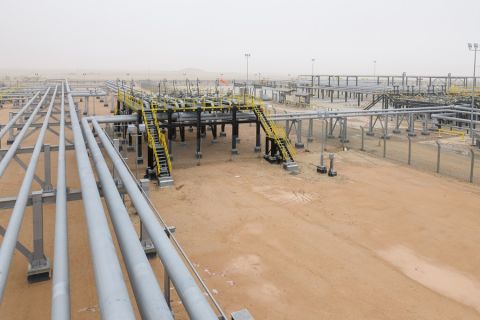
(Source: Lightspring/Shutterstock.com)
HOUSTON—Could oil and gas—the energy power couple often referred to as one by industry insiders and outsiders—be headed for divorce amid growing ESG pressures?
That was the topic at hand as Stephen Perich, managing director and head of energy-Americas for UBS Investment Bank, took the stage Oct. 20 for Hart Energy’s Energy Transition Capital Conference. Like the breakup of cigarettes and beer decades ago, Perich pointed out, a divorce could happen with the right catalyst.
The two appear to be on divergent paths given differences in their carbon footprints. A collaborative and strategic approach is needed, considering natural gas pure-plays don’t exist, he said. The approach could help doubters see the benefits of natural gas, which remains tied to higher carbon-intense crude oil.
“Perception is reality, and today the perception is that natural gas is worth betting on. I would love it if natural gas could pull its older oil brother along and make it cleaner and more attractive to investors and politicians,” Perich said. “But I’m actually more worried about the opposite outcome, where the perceived taint around crude oil could actually pull natural gas down and make the market ignore the many environmental and economic benefits.”
The words were spoken as the global green-energy push strengthens. Many energy companies and other businesses have set net-zero targets to reduce the amount of emissions released into the atmosphere. Efforts are wide-ranging as companies focus on emissions detection technologies at energy production sites, carbon capture and storage onshore and offshore, and production of renewable energy such as wind and solar along with hydrogen fuel.
Seeing the Benefits
Natural gas, which emits fewer CO2 emissions than coal and oil, is seen as a bridge fuel in the energy transition. If its methane emissions are successfully tackled by mitigating flaring among other methods, its benefits could be maximized.
“Reality is you cannot have a net-zero model that works without growing natural gas; it just doesn’t work,” Perich said. “You have to have some contribution from base energy to get there to net zero and still have enough energy to supply the world.”
Energy demand forecasts point to a bright future for natural gas, according to Perich. He highlighted outlooks from the International Energy Agency (IEA), OPEC, Equinor and BP, which showed natural gas growth through 2050 at 11.4%, 27.9%, 22.1% and 35.9%, respectively.
Crude oil, on the other hand, has a “trajectory that looks more like coal,” he said. The IEA forecasts oil demand falling by 20.7%, or about 20 million barrels in about 30 years; OPEC, 1.4%; Equinor, 16.7% and BP, 11.6%.
“That looks like a tough industry to be in,” Perich said. He questioned whether natural gas wanted to stay tethered to a declining commodity that is unfavored by some.
Why would natural gas want to distance itself from its fellow fossil fuels?
Environmental advantages are plentiful. As Perich explained, natural gas:
Displaces Coal. The world could pull a page from the U.S. shale playbook. Development of natural gas from shale plays helped displaced coal, reducing emissions. “In 2005, 50% of the U.S. power generation came from coal. It had a half of the market,” Perich said. “In just 15 years, that has been cut to less than 20%, and almost all of that went to natural gas.”
Fuels Renewables. Natural gas is used to produce blue hydrogen, unlike green hydrogen that relies on electrolysis which utilizes renewable power such as wind and solar. Perich noted that it’s cheaper to produce blue hydrogen. Added bonuses: natural gas infrastructure already in place could be retrofitted, and major midstream players are already making investments.
Requires Less Land. Perich said a lot of acreage is needed for wind turbines and solar panels. He used the amount of land needed to power a flat screen TV as an example: wind requires 37 square meters and solar needed 14 square meters, while natural gas required only a fraction of that. Plus, the renewable sector requires large amounts of mined metals such as lithium, nickel and iron are needed, too.
Could a Divorce Happen?
“It seems crazy, but we’ve seen it before. Other industries have had famous divorces,” he said, turning to beer and cigarettes. “People may not remember, but in the ‘50s and early ‘60s, these two were part of an aligned recreation industry. They lobbied together and even marketed together.”
Unfathomable today, commercials advertising Winston cigarettes and Busch beer featured cartoon characters Fred and Barney from The Flintstones decades ago.
The two eventually separated.
“It needed a catalyst, something unforeseen by the market to break up these two partners,” Perich explained, “and that was the surgeon general’s warning that tobacco will kill you much quicker than the beer will.”
Coffee and newspapers, which Perich said often moved in tandem with similar-sized markets and revenue, had a similar fate. The catalysts: Internet and Starbucks.
Despite its environmental benefits, natural gas is sometimes labeled as a “dirty fuel” and often packaged in nomenclature with other fossil fuels. There are consequences to that, according to Perich.
“Natural gas producers are absolutely lumped in with coal and oil in many instances when it comes to getting loans from banks,” he said. “Earlier this year the federal government was pushing on all the big money houses in the U.S. to not lend to oil and gas companies.”
The story is similar with large asset managers and endowment funds looking to cut ties with fossil fuels. “All that leads to a higher cost of capital,” he said. That doesn’t bode well for a commodity that is already expensive to produce and has more market volatility.
So, what can be done to boost natural gas during the energy transition?
For starters, Perich suggested:
Stopping use of terms like “oil and gas,” “hydrocarbons” and “fossil fuels.” Instead, use “energy” and distinguish natural gas;
Investing in environmental initiatives that include not only carbon capture but also remediating production sites and reforestation. APA Corp. (Apache), for example, has donated more than 4.8 million trees since 2005 to U.S. nonprofit and governmental organizations via its tree grant program, according to the company’s website.
Shifting lobbying efforts to focus more on the environmental benefits of natural gas.
“When you look at the totality of natural gas and its impact on the environment, it’s incredibly positive,” Perich said.”
Recommended Reading
FERC Again Approves TC Energy Pipeline Expansion in Northwest US
2024-04-19 - The Federal Energy Regulatory Commission shot down opposition by environmental groups and states to stay TC Energy’s $75 million project.
Eversource to Sell Sunrise Wind Stake to Ørsted
2024-04-19 - Eversource Energy said it will provide service to Ørsted and remain contracted to lead the onshore construction of Sunrise following the closing of the transaction.
Shipping Industry Urges UN to Protect Vessels After Iran Seizure
2024-04-19 - Merchant ships and seafarers are increasingly in peril at sea as attacks escalate in the Middle East.
Paisie: Crude Prices Rising Faster Than Expected
2024-04-19 - Supply cuts by OPEC+, tensions in Ukraine and Gaza drive the increases.
Brett: Oil M&A Outlook is Strong, Even With Bifurcation in Valuations
2024-04-18 - Valuations across major basins are experiencing a very divergent bifurcation as value rushes back toward high-quality undeveloped properties.





